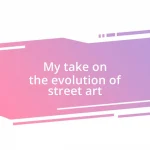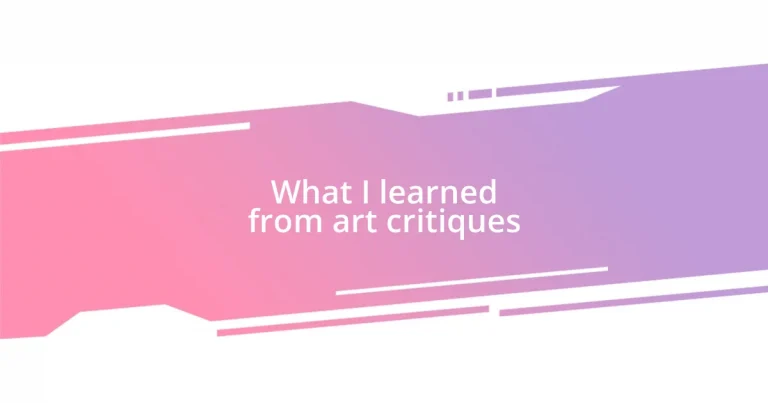Key takeaways:
- Receiving feedback is essential for artistic growth, helping artists to see their work from new perspectives and fostering resilience.
- Identifying strengths and areas for improvement through critiques enhances confidence and drives artistic development.
- Building a supportive critique network fosters an environment of growth and collaboration, enriching creative practices through diverse perspectives.

Importance of receiving feedback
Receiving feedback is crucial for growth in any creative field. I remember the first time I shared my work with a group. The sense of vulnerability was overwhelming, but the insights I received—each one a blended mix of praise and constructive criticism—transformed my work for the better. Isn’t it fascinating how someone else’s perspective can shine a light on aspects of our art that we might be too close to see?
Feedback, in my experience, acts like a compass guiding me toward improvement. One particular critique I received inspired me to delve deeper into colors and emotions in my paintings. Before that feedback, I was content with surface-level choices, but understanding how my color palette impacted the viewer’s experience changed everything. Have you ever had a moment where someone pointed something out that shifted your entire approach?
Embracing feedback can feel uncomfortable, but it truly fosters resilience and adaptability. I’ve learned to view critiques not as personal attacks but as valuable insights that push me forward. Each conversation around my art has taught me that it’s not about being perfect; it’s about evolving. How do you see feedback shaping your creative journey?

Identifying strengths in artwork
Identifying strengths in artwork isn’t just about pointing out what’s good; it’s about understanding what resonates with others. Once, during a group critique, a fellow artist highlighted the intensity of emotion in one of my sketches. It was a simple observation, yet it opened my eyes to a vibrant aspect of my work that I had overlooked. That moment became a turning point, where I realized that tapping into emotions could be a defining strength in my artistic voice.
To pinpoint strengths in artwork, consider the following aspects:
- Composition: Does the arrangement of elements guide the viewer’s eye effectively?
- Color Harmony: Are the colors working together to evoke a specific mood?
- Technique: Is there a mastery of the chosen medium that stands out?
- Originality: What unique elements differentiate this piece from others?
- Emotional Impact: How does the artwork make you feel? What reactions does it evoke in the audience?
Recognizing these strengths not only boosts confidence but also lays a foundation for future growth. It’s exhilarating to see how a few targeted strengths can transform an artist’s journey, leading to more refined and powerful expressions in subsequent works.

Recognizing areas for improvement
Recognizing areas for improvement in my artwork has been a journey of both discovery and vulnerability. In one of my earliest critiques, I received feedback about my use of perspective. Initially, I felt defensive, believing my drawing skills were strong enough. But as I reflected on the comments, it became clear my perspective was often flat and lacked depth. This realization was humbling yet liberating—it motivated me to study perspective techniques more rigorously and incorporate them into my future pieces. Have you ever found yourself questioning a skill you thought you excelled at?
I also learned to embrace constructive feedback regarding my brushwork. A mentor once pointed out that my lines could be more expressive; they felt rigid at times. This comment hit close to home. I understood that my fear of imperfection stifled my natural rhythm. Since then, I’ve intentionally loosened my grip on the brush, allowing for more spontaneity in my strokes. It’s a thrilling process, witnessing how this adjustment invites more life into my art. What aspects of your technique could benefit from a fresh approach?
Engaging with critiques taught me the importance of continuous learning; I’ve learned to perceive art as a dynamic, evolving dialogue rather than a static endpoint. Additionally, I’ve jotted down all the suggestions during critiques, creating a personal roadmap to address these areas for improvement. In fact, I recently revisited an older piece after six months of focused practice and was amazed at how my newfound skills transformed it. This experience reassured me that growth is not just possible; it is exhilarating.
| Area for Improvement | Insight Gained |
|---|---|
| Perspective | Improved depth and spatial awareness in artwork |
| Brushwork | Increased expressiveness through looser strokes |

Strategies for responding to critiques
When responding to critiques, I’ve found that taking a moment to breathe and reflect can be transformative. One time, during a particularly intense critique session, a fellow artist suggested that my work felt disjointed. Instead of reacting defensively, I paused to truly absorb their perspective. This approach helped me see that my emotions were clouding my judgment, and by stepping back, I could explore how to weave a more cohesive narrative in my art.
Another strategy I regularly employ is actively seeking clarifications on feedback I don’t fully understand. During one critique, a mentor remarked that my color choices were “chaotic.” Rather than dismiss this, I asked for specific examples of where I could improve. This led to an enlightening discussion, helping me realize that my color palette wasn’t just random; it lacked harmony and intentionality. It was a valuable lesson for me—how often do we miss growth opportunities simply because we don’t dare to ask?
Lastly, I’ve learned the importance of following up with critics after they’ve provided their insights. I remember reaching out to an artist whose critique had shaken my confidence. I wanted to know more about their thought process. They generously shared their creative journey, reminding me that even seasoned artists grapple with challenges. This conversation not only healed my initial doubts but sparked new ideas in my practice. How can we deepen our understanding of ourselves and our art if we don’t engage in these meaningful exchanges?

Applying critiques to future projects
Applying critiques to future projects has reshaped how I approach my art. Just recently, I decided to experiment with a new medium after a critique highlighted my tendency to stay within my comfort zone. I remember the thrill of trying out watercolors for the first time; the unpredictability of the medium taught me to embrace uncertainty. Have you ever taken a leap into a new medium or technique that felt intimidating but ultimately rewarding?
As I integrated the feedback I received into my work, I also began to document my artistic journey in a sketchbook. This practice allows me to correlate critiques with specific projects, mapping out my growth over time. One entry stands out—after revisiting a piece that had been critiqued for its lack of emotional depth, I infused my latest work with personal narratives and feelings. This shift has not only transformed my art but deepened my connection to it. Do you ever look back and see how past critiques have guided your evolution as an artist?
Moving forward, I’ve learned that each critique offers a domino effect for future projects. I often find myself revisiting critical feedback just before starting a new piece, almost like a mental checklist. It’s empowering to realize that instead of shying away from criticism, I can lean into it like an artist’s compass, guiding me toward better outcomes. This transformation in mindset helps to quell the initial sting of critique and inspires me to push my boundaries. How do you think past critiques shape your future creations?

Building a critique network
Building a critique network has been a pivotal part of my growth as an artist. Early in my journey, I sought out fellow creatives who shared my passion for honest feedback. I remember attending a local art collective meeting where artists openly discussed their work. The warmth in that room encouraged me to share my pieces, knowing that each critique would come from a place of support and understanding. Isn’t it amazing how a welcoming environment can make us feel safe enough to be vulnerable?
As I expanded my critique network, I found the diversity of perspectives incredibly valuable. Engaging with artists from different backgrounds and styles enriched my understanding of art. One memorable conversation was with a sculptor who challenged me to think about three-dimensional space in my paintings. Their insights knocked down the walls I had built around my creativity. Have you ever considered how collaborating with artists outside your niche can reveal new dimensions to your work?
I’ve also discovered the importance of nurturing these relationships over time. Building a critique network isn’t just about receiving feedback; it’s about fostering a community of reciprocal growth. After a significant critique session, I took the initiative to host informal meetups where artists could gather and share their progress. One evening, a fellow artist expressed gratitude for the safe space we created, and I felt a profound connection—a reminder that nurturing these bonds could lead to lifelong friendships and endless inspiration. How do you cultivate supportive relationships in your artistic endeavors?












